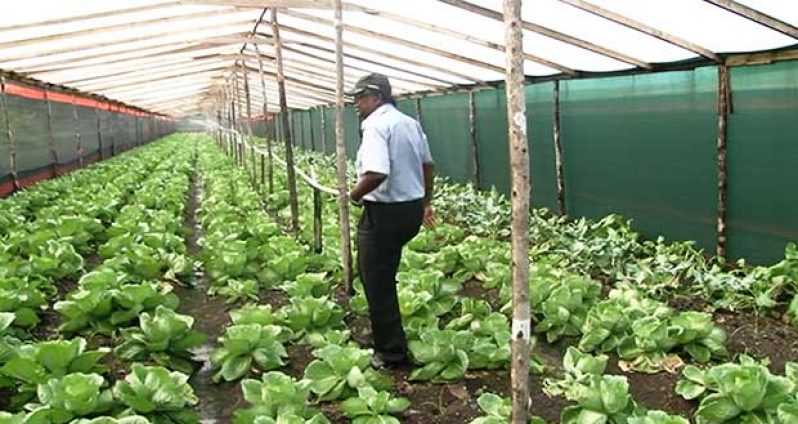For a number of years, the National Agricultural Research and Extension Institute (NAREI) has been encouraging farmers to incorporate new or modern technologies in their operations- one such technology is the shade house.

Crops grown under shaded conditions are protected from harsh weather conditions and have minimal exposure to pests and diseases. In fact, shade house cultivation could be farmers’ solution to the adverse effects climate change has on the environment.
Locally, some cash crop farmers have begun to invest in shade house cultivation. Recently, Chief Executive Officer of NAREI, Dr. Oudho Homenauth and staff visited a farm in Canal No.2 Polder, West Bank Demerara, where shade house cultivation is being done one a large scale. The farm is owned by Mr. Jagdeo Lakhan.
Setting up the Shade House
In December 2015, Lakhan with the assistance of NAREI erected shade houses on his farm. The materials were procured by NAREI but, of course, the farmer footed the bill. NAREI provided the technical support during the construction phase.
Constructing a shade house is simple. Important materials needed are mesh, plastic, wood and PVC pipes (for the automated sprinkler system). Generally, the beds are either raised or in the ground. The cost of investment depends on the size of the shade house. Planting crops under shaded conditions have been proven to be lucrative, however, farmers are advised to start small, Dr. Homenauth posited.

Collaboration with NAREI
Lakhan’s shade houses are used sometimes by NAREI for demonstration and trial purposes. NAREI is currently utilizing two beds in one of the shade houses to conduct broccoli and cauliflower trials, as part of the Ministry of Agriculture’s crop diversification programme. These exotic crops do not grow in tropical regions and therefore need shaded conditions to strive.
They are being grown alongside beds of cabbages, which are being produced for commercial purposes. The same care and attention (such as daily irrigation and monitoring for pests) that are given to the cabbages are given to the trial crops. NAREI’s staff visit the farm regularly to monitor the trails.
Control of Pests and Diseases
The noticeably high quality of crops in the shade houses vindicates the notion that green leafy vegetables grow well under shaded conditions. While, shade houses do not eliminate the spread of pests and diseases they do reduce the incidences. This is a major advantage over traditional farming, which is done in open fields. Traditional farming exposes crops to environmental changes such as extended dry periods, water stress, and pest and diseases.
Crops planted in the shade houses were not adversely affected by the effects of the recent El Nino period, said Narine Persaud, the farm manager. In fact, the construction of the shade houses was inspired by the prolonged dry period in 2015 that ended in April 2016.
He related that the crops are flourishing in the shade house. “The crops hardly get pests and so we do not have to use a lot of chemicals and this is a saving for us,” Persaud added.
Another financial benefit of shade house cultivation is low labour cost. Persaud explained that only one person is needed to turn on and off the sprinkler irrigation system. Moreover, little maintenance in terms of the clearing of weed is required.
Food Security
Crops could be grown all year-round in shaded houses. This is the ideal technology local farmers need to employ for Guyana to achieve food security.
“…from the standpoint of the Institute the technology we develop must be transferred…And apart from developing the technology we measure our success from the adaption of the technology. Adaption means by adaption by farmers because it’s for their benefit,” Dr. Homenauth said.



.jpg)











